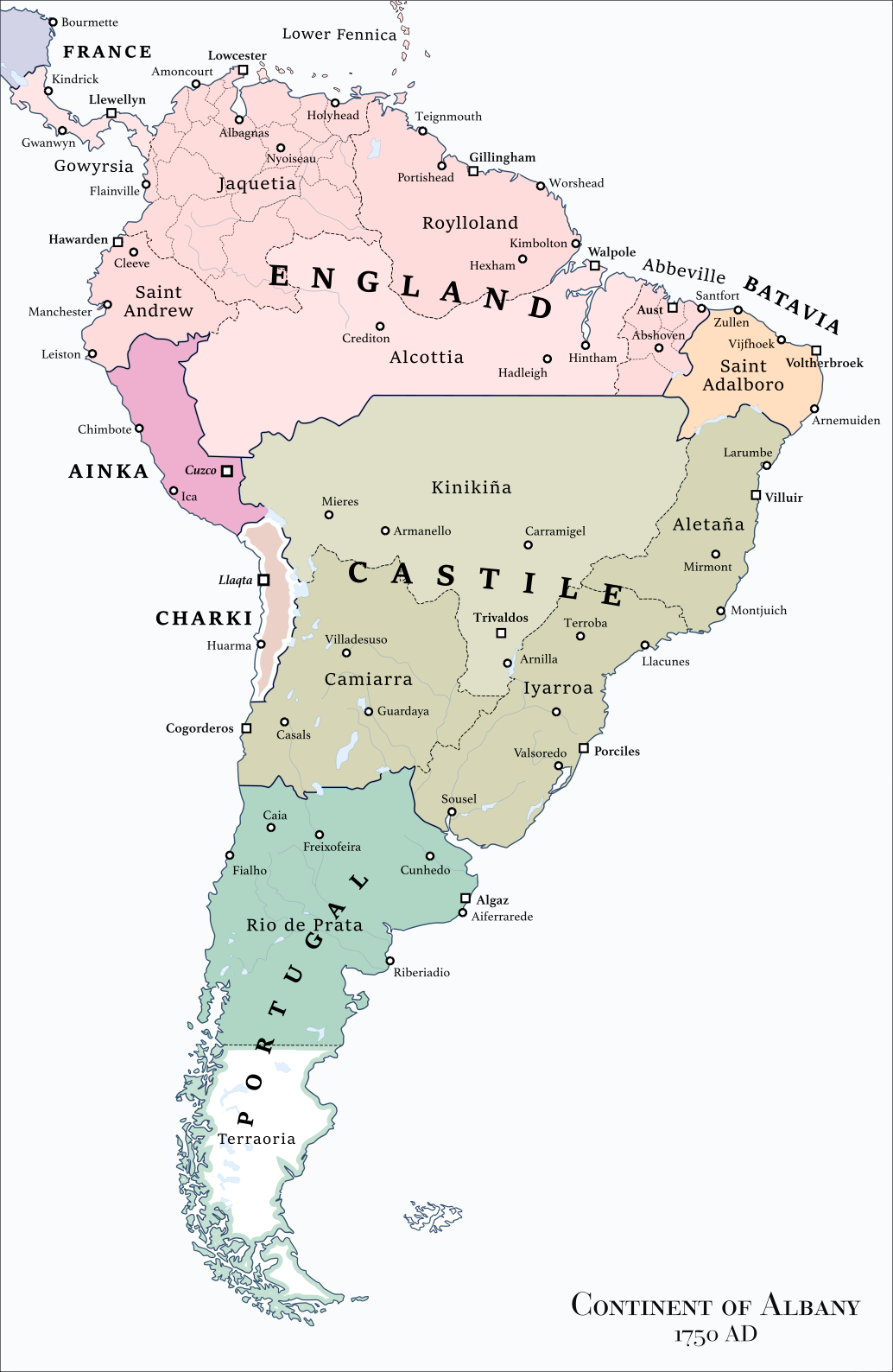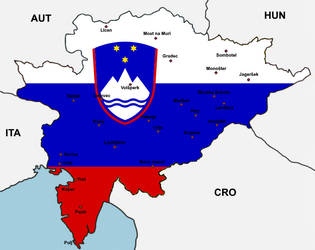Deviation Actions
Description
-------------------------------------------------------------
Albany, sometimes called Escocia, is the continent connecting to Litirland in the south. Named after the old Frygian name for the area, Albany could be described as the “colonized continent”, as it was one of the places most heavily settled by Europeans. While Litirland was slowly encroached by Danes and the half-native Frygians, Albany was quickly swept up in the spread of disease and European colonialism. While the natives of Albany, especially the ones in the north, were mostly immune to the diseases brought by Frygia at this point, tribes like the Mapuche in the south nearly died out completely after the Portuguese set up their first trade post. The Portuguese, Castilians, and Aragonese began to use the abandoned cities and villages to their own benefit, seizing the abandoned fields and houses for themselves. The English, on the other hand, had a much more invested way of settling their colonies. Many of the religious groups not well-liked by the English, or those practicing branches of Scandinavian Christianity, were commonly forced to move and settle in the New World. In 1582, the colony of Holyhead was founded to the south of English Fennica (which had belonged to them for a while), filled to the brim with Thyrenian Christians (essentially a branch of Scandinavian Christianity under an English leader who lived in the 1400’s). In 1584, the town of Abbeville was founded, with the city of Aust right next door. Both towns practiced a type of Greek Orthodox Christianity, something not well-received by the government. In 1606, the city of Kindrick was suddenly overtaken by Welsh townsmen, as the English tried to drain them of their culture. The city of Llewellyn was created in the midst of the migration, and proved to be a valuable trading port.
Through the early 17th century, the rapid-fire expansionism of the English colonies played its part in the colonization of Albany. Agreements were made with Castile to divide up the insular rainforest, while Portugal took up the south. Aragon divided up its one colony of Aletaña between the Castilians and the Batavians (who renamed their portion “Saint Adalboro”). The Ainka and Charki kingdoms, having existed since the early-1300’s, were allowed to live only due to past precedent, and would essentially become vassals of the English by 1625. The colonies of Jaquetia and Roylloland were both formed in 1614. Jaquetia consisted of the western coast, going all the way down to the northern border with Ainka. In 1627, the southern part of Jaquetia split off into the more conservative province of Saint Andrew. The English began to offer incentives for settling in Albany, hoping to eventually take control of the Castilian and Portuguese colonies. Huge land grants were given in Jaquetia, essentially creating a style of fiefdom. Eventually, England made enough money off of the gold mining tariffs to buy out the colony of Holyhead, merging it with Jaquetia. Although there was a little trouble with the city of Nyoiseau during the merger, it quickly worked itself out.
In the 1630's, the English colonies were overcome with immigrants. The colonies became a no-mans-land in the eyes of the settlers. Religions disliked by London were kicked to Abbeville. French the English wanted to get rid of were sent to Nyoiseau. The Welsh opted to leave themselves, turning the peninsula they called Gowyrsia into a New Wales. While England was doing a good job about removing the heavy French influence from their culture by exiling them to Albany, it wasn't making anything more stable. A succession of three rebellions swept the home isles after the racist wrongdoings of England reached they're height. First, the Welsh in Caerdydd rebelled for an autonomous province. The government responded by giving Gowyrsia autonomy, and pushing more of Wales into Llwellyn and Gwanwyn. The second little rebellion was of the English in London who wanted part in the fur trade, which places like Scotland were getting rich off of. The rich plantations in Jaquetia were good for business, but not as good as Scandinavian Herbergia. Sadly, England couldn't exactly stand up to the might of Scandinavia, and cowered at the call to war. The revolution slowly petered out.
Seperately, the third rebellion became one of the largest changes on the continent of Europe in the 1600's. In 1651, the puppet kingdom of Haute-Normandie rebelled against English ownership, and English Aquitaine followed suit. France, having been in a dynastic union with Savoy since 1642, quickly swept in and took over parts of it. England was able to defend themselves, but just barely. By the end of the "revolution", they'd lost parts of Normandy, Aquitaine, and the entirety of Haute-Normandie. Luckily, this only helped to elimiate their whole "French or English" identity crisis, and allowed them to be ever so slightly more cruel to their colonies. Cutting ahead a century, everything's basically the same as it was at the end of the third rebellion. Immigration from Wales increased, while an Anglo-French culture arose in the *Amazon. Still, there haven't been any successful colonial rebellions just yet, and England prays they'll never come...



























![[RTL] Rise of the Corean Empire (1888)](https://images-wixmp-ed30a86b8c4ca887773594c2.wixmp.com/f/32947cf7-5973-49ed-a695-42c68ee0327a/degryqr-53cdb2c2-b693-4d1f-8d4f-a70546da62d3.png/v1/crop/w_184)








